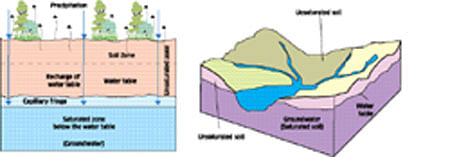Trees can raise groundwater table

That changed quickly with the formation of new layouts in the region, leading to the drastic decline in the groundwater table. The good lake which once was home to hundreds of migratory birds is now dry, despite the ‘ rejuvenation’ by the State Government in the year 2000. The residents around Thindlu are now facing a severe water crisis with the water level having dipped below 700 feet.
The situation faced by the residents of Koramangala Games Village is not much different. The vegetation has been removed and replaced with concrete structures of stadium and apartments, that has prevented rainwater seepage. As a result, the water table has gone down by 600 feet and the residents are feeling the heat of water scarcity.
It is evident from these examples that vegetation plays a significant role in recharging the groundwater table and the City’s growing built-up area is the reason for the depletion of water sources.
Experts at the Indian Institute of Science (IISc) cite several examples about how vegetation rich areas like its campus have seen an increase in water table.
“Land cover is important in deciding water availability. Vegetation allows percolation and enriches the water table,” says Dr T V Ramachandra, Senior Scientist, Energy and Wetland Research Centre (EWRC), Centre for Ecological Sciences (CES) at IISc.
Explaining the phenomenon how vegetation allows the water to be retained, Dr Ramachandra says: “Recharging groundwater requires 30-40 per cent of open space with vegetation. The vegetation makes soil pervious and helps in percolation.”
The vegetation holds the water filling in the saturated zone first, then the second layer above saturated zone known as widow zone, is filled up. The runoff seen in the monsoon is a phenomenon which happens only when both the layers are filled.
Citing the examples of K R Puram, Whitefield and ITPL regions, Dr Ramachandra notes that these places have lost vegetation drastically. Increased vegetation, asserts Dr Ramachandra, is the solution to depleted ground water table. But the best results would come if the vegetation is of native species. His study had found that the native species with their root structures percolates water much more than foreign species. “The native plant species have low rate of transpiration and high rate of recharge,” he explains.
Vegetation loss has transformed Bangalore:
* The consequences of urban development are increased peak discharge and frequency of floods. As land is converted from fields or woodlands to roads and parking lots, it loses its ability to absorb rainwater.
* Conversion of water bodies to residential layouts has compounded the problem by removing the interconnectivities in an undulating terrain. Encroachment of natural drains, alteration of topography are the prime reasons for frequent flooding even during normal rainfall post 2000.
* The urbanisation process in Bangalore has resulted in loss of aquatic ecosystems by 79 per cent during 1973-2010 in the erstwhile Bangalore City limits and 75 per cent decline in vegetation.
Deccan Herald is on WhatsApp Channels| Join now for Breaking News & Editor's Picks